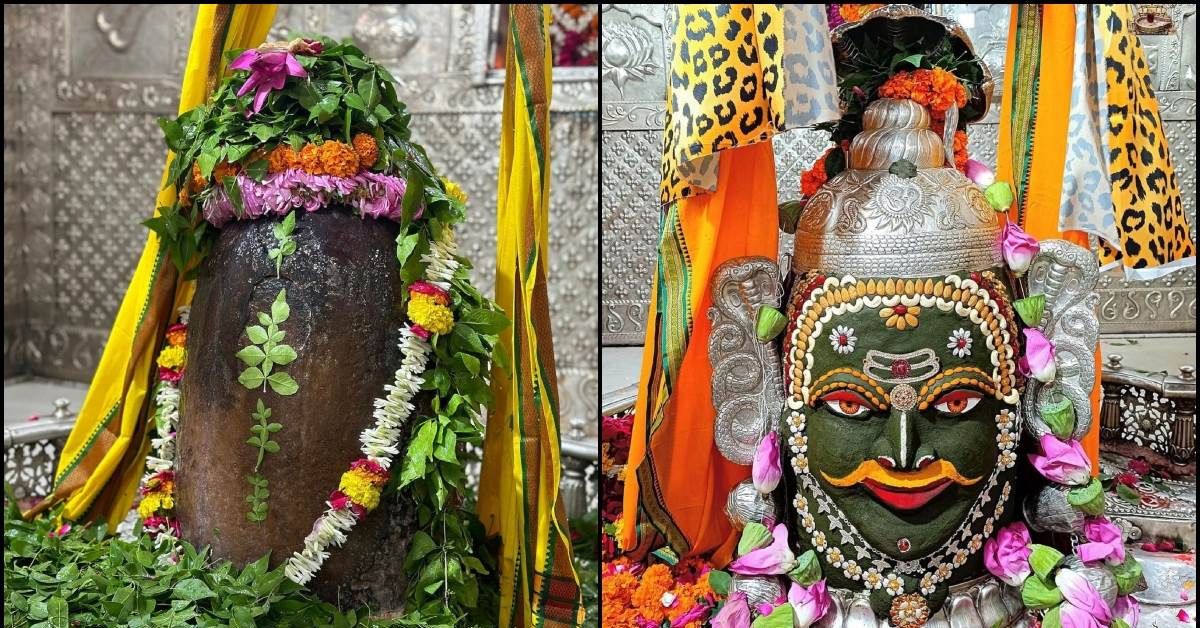Steeped in history and radiating spiritual significance, the Mahakaleshwar Temple in Ujjain, Madhya Pradesh, is a crown jewel of Shiva worship in India. This revered temple enshrines one of the twelve Jyotirlingas, the holiest abodes of Lord Shiva. Millions of devotees and pilgrims flock to Mahakaleshwar Temple, drawn not only by its rich past but also by the profound spiritual atmosphere that permeates the very stones.
The temple’s grandeur is undeniable. Situated along the banks of the sacred Shipra River, Mahakaleshwar offers a serene escape, a place where the devout can embark on a transformative journey of devotion. The intricate carvings and sculptures that adorn the temple complex weave a visual tapestry of Hindu mythology, further enriching the experience for visitors.
How to reach:
By Air: The closest airport is Indore’s Devi Ahilya Bai Holkar Airport, roughly 55 kilometers away. Indore boasts excellent connections to major Indian cities like Delhi, Mumbai, Bangalore, and Hyderabad. Taxis and buses are readily available at the airport to transport you to Ujjain.
By Train: Ujjain Junction is a major railway station with connections to numerous Indian cities, including Mumbai, Delhi, Kolkata, Chennai, and Bhopal. Regular trains like the Avantika Express, Malwa Express, and Shipra Express make travel to Ujjain convenient. The temple is just 2 kilometers from the station, easily reachable by auto-rickshaw or taxi.
By Road: Ujjain is well-connected by road to major cities in Madhya Pradesh and neighboring states. You can choose from:
- Buses: Regular government and private buses operate from cities like Indore, Bhopal, and Ahmedabad to Ujjain. The Ujjain Bus Stand is conveniently located near the city center, making it easy to reach the temple.
- Taxis/Car Rentals: For a more comfortable and flexible journey, consider hiring a taxi or renting a car from nearby cities like Indore or Bhopal.
Best time to visit:
Winter: (October – March)
Ujjain welcomes you with open arms during winter, boasting comfortable temperatures between 10°C and 25°C. This pleasant weather makes exploring the temple and city a delight. Winter also coincides with significant festivals like Maha Shivaratri, typically falling in February or March. During this vibrant celebration, the temple transforms with beautiful decorations and special rituals, attracting a multitude of devotees and creating an unforgettable spiritual experience. The moderate climate and festive spirit make winter the ideal season for your pilgrimage.
Monsoon: (July – September)
The monsoon season paints Ujjain a verdant picture with moderate rainfall and temperatures ranging from 22°C to 28°C. The city awakens to a lush green landscape, enhancing the natural beauty surrounding the temple. This period offers a peaceful experience due to the fewer crowds compared to other seasons. However, humidity and occasional heavy showers might be a concern for some visitors. Nevertheless, the serene ambience and rejuvenated surroundings can make your trip truly memorable.
Summer: (April – June)
Ujjain summers can be quite challenging, with temperatures reaching highs of 45°C. The intense heat during the day can make sightseeing and temple visits strenuous. However, mornings and evenings offer some respite with cooler temperatures, providing a window of opportunity for those who can tolerate the heat. The advantage of visiting during summer is the significantly reduced crowds, allowing for a quieter and more personal experience at the temple. If you plan a summer visit, schedule your temple visits during the cooler mornings or evenings to avoid the peak heat.
Special Events and Festivals
- Maha Shivaratri: Celebrated with immense fervor at Mahakaleshwar Temple, Maha Shivaratri marks the night of Lord Shiva’s cosmic dance. The temple adorns itself with breathtaking decorations, and special rituals and prayers resonate throughout the night. While the temple becomes crowded, the unparalleled spiritual atmosphere creates a unique and enriching experience for devotees and visitors alike.
- Kumbh Mela (Simhastha): Held every 12 years in Ujjain, the Kumbh Mela, or Simhastha, is a grand spectacle that attracts millions of pilgrims worldwide. This massive gathering offers a unique cultural and spiritual experience, but be prepared for enormous crowds and logistical challenges. Witnessing and participating in ancient rituals and traditions during the Kumbh Mela is a rare opportunity to experience faith and devotion on a grand scale.
- Shravan Month (July-August): Considered highly auspicious for devotees of Lord Shiva, the Shravan month witnesses a significant surge in visitors to Mahakaleshwar Temple. Mondays, especially dedicated to Lord Shiva, see the temple teeming with devotees performing special prayers and rituals. This period offers a deeply spiritual experience, as the temple atmosphere is charged with devotion and reverence.
Attractions:
Mahakaleshwar Jyotirlinga:
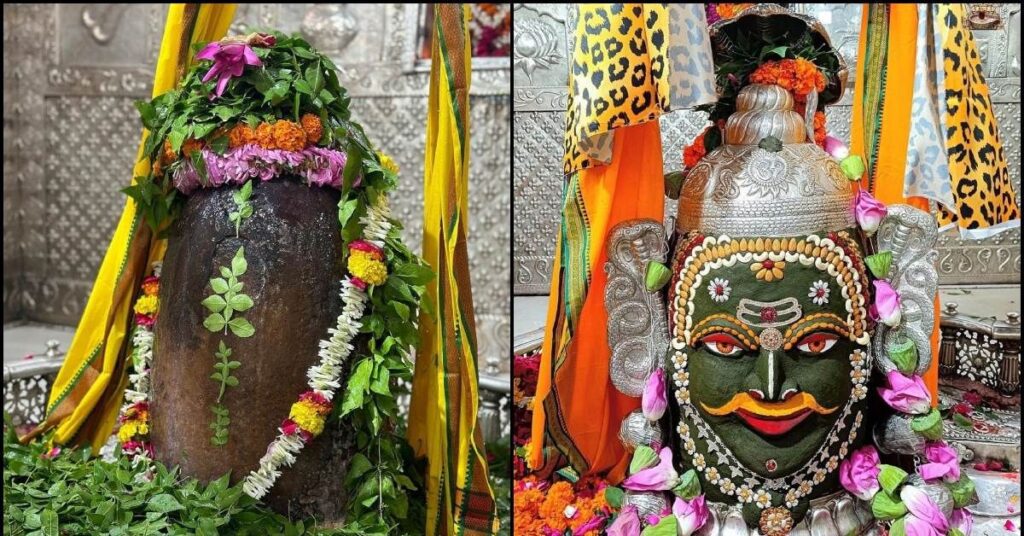
The soul of the Mahakaleshwar Temple lies in the Mahakaleshwar Jyotirlinga, one of the twelve most sacred abodes of Lord Shiva. Unlike any other Jyotirlinga, this one is revered as Swayambhu, meaning self-manifested. This divine distinction sets it apart, believed to have emerged of its own accord rather than being established through a specific act of Lord Shiva’s will. Enshrined within the garbhagriha (inner sanctum), the Jyotirlinga pulsates with an aura of profound spirituality and devotion. Pilgrims from all corners of the world are drawn to this sacred site, offering prayers, performing rituals, and seeking blessings.
Bhasma Aarti:
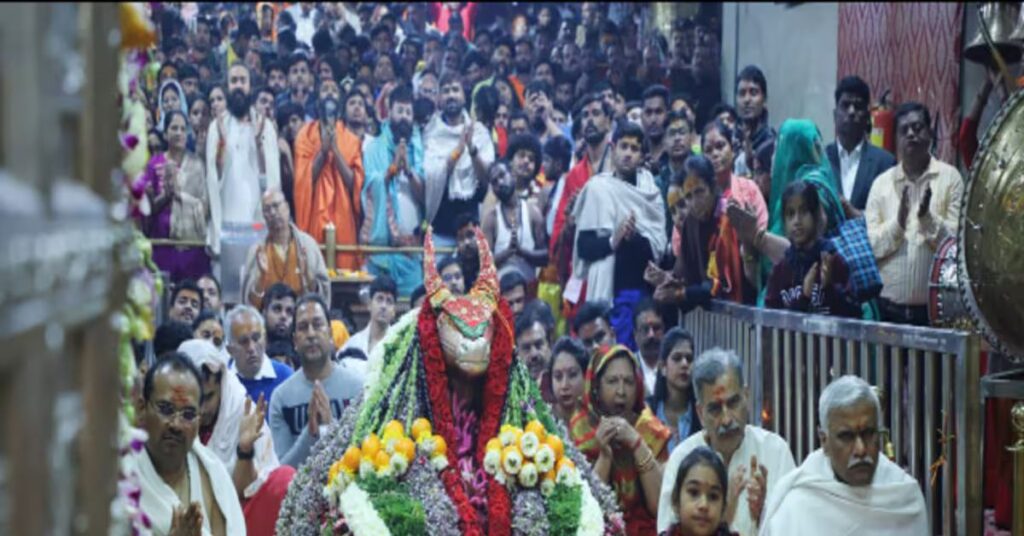
The Mahakaleshwar Temple awakens each morning to a truly distinctive ceremony: the Bhasma Aarti. This captivating ritual, held at 4 am daily, sees the Shiva lingam adorned with sacred ash, or bhasma. Witnessing the anointing of the lingam with ash is a mesmerizing experience for devotees. But the Bhasma Aarti transcends mere spectacle; it’s a profound spiritual encounter. The ash symbolizes the impermanence of earthly existence, while the lingam itself represents the enduring power of the divine. Many devotees rise before dawn to participate in this auspicious event. The rhythmic drumming, the chanting of mantras, and the ethereal atmosphere during the Bhasma Aarti create a palpable sense of devotion and reverence. It’s believed that witnessing this sacred ritual purifies the soul and invites the blessings of Lord Shiva. For pilgrims visiting Mahakaleshwar, attending the Bhasma Aarti is a truly unforgettable experience.
Ganesh Mandir:
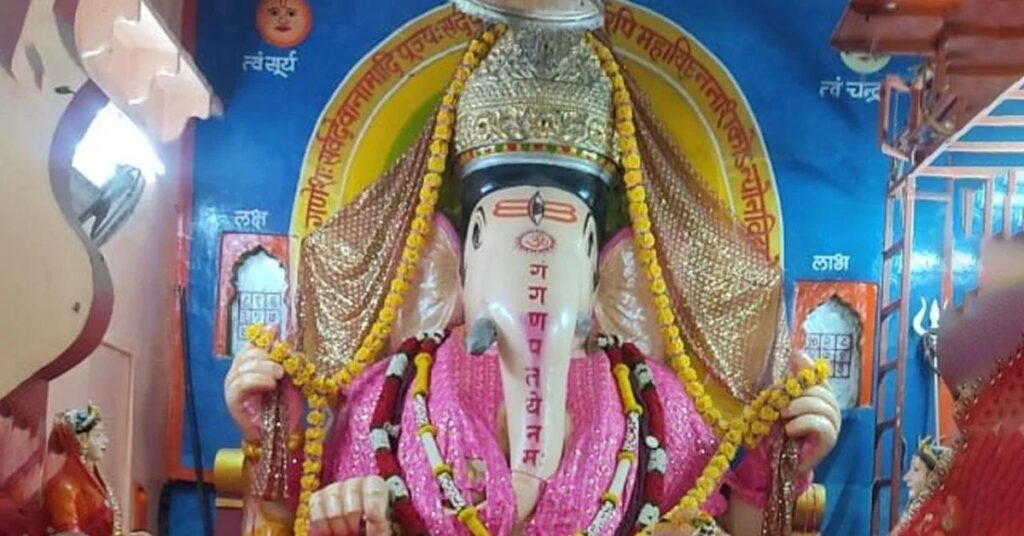
Nestled within the vast Mahakaleshwar Temple complex is the Ganesh Mandir, a haven dedicated to Lord Ganesha, the elephant-headed deity of wisdom and auspicious beginnings. Though smaller in size compared to the main temple, this significant shrine is a magnet for devotees seeking blessings for new ventures and success in their endeavors.
The murti (idol) of Lord Ganesha here is depicted in the traditional form, adorned with vibrant flowers and offerings left by devotees. Often bustling with worshippers, the Ganesh Mandir is a popular stop within the complex. Here, devotees come to pay their respects, perform pujas (rituals), and seek guidance from Lord Ganesha.
Nagchandreshwar Temple:
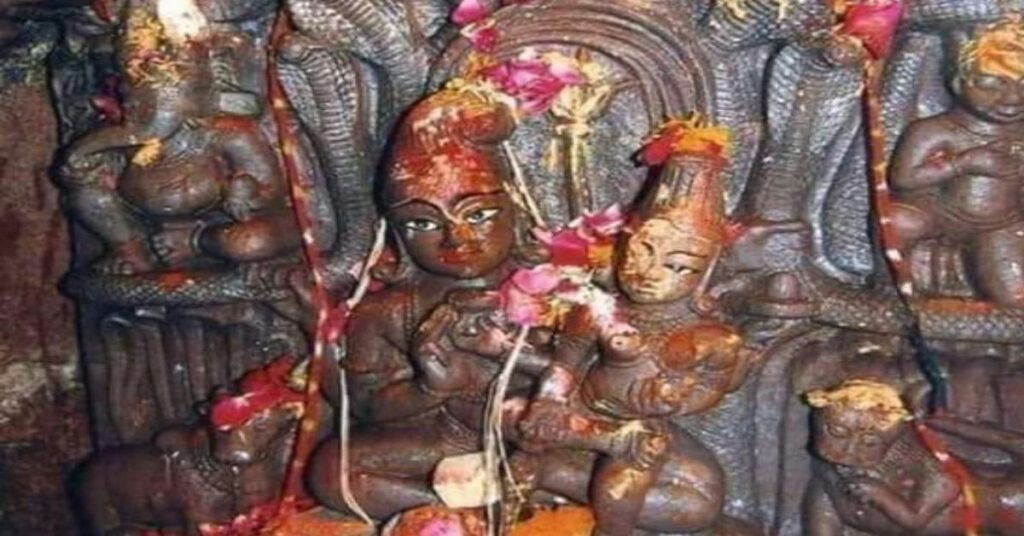
Nagchandreshwar Temple, Unlike its grand neighbor, this unique shrine is shrouded in a veil of mystery. Dedicated to both Lord Shiva and the Nag Devta (Serpent God), the Nagchandreshwar Temple holds significance for its rarity and the specific occasion it marks.
Unlike most temples, this one opens its doors to devotees just once a year – on Nag Panchami, a festival dedicated to serpent deities. This exclusivity adds to the temple’s mystique and spiritual allure. Inside, visitors are greeted by a unique sight: an idol depicting Lord Shiva and Parvati seated regally on a throne of serpents, with other serpent figures adorning the space. The intricate carvings and the very form of the idols serve as a powerful symbol of the serpent deity, highlighting the temple’s unique place within the Mahakaleshwar complex.
Koti Tirtha:
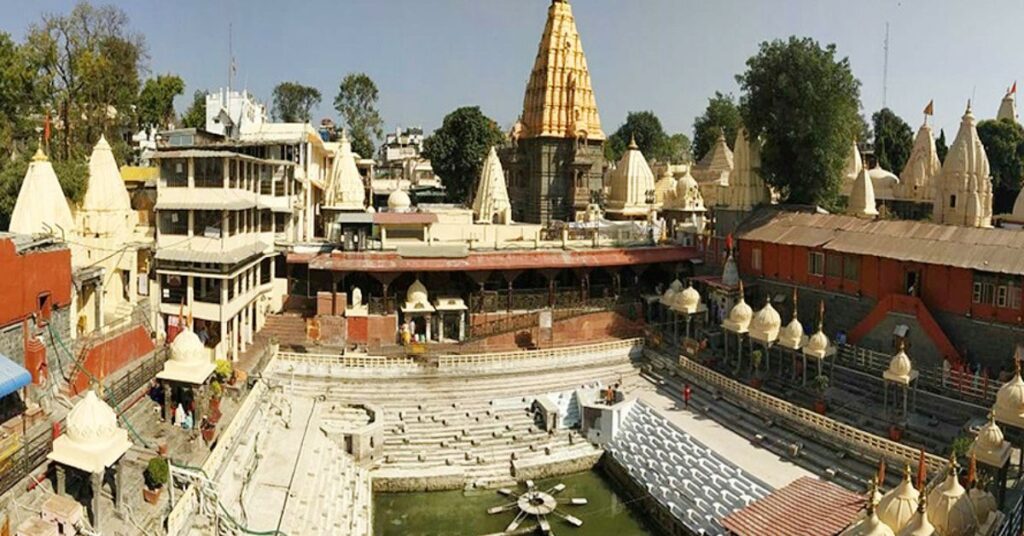
Within the Mahakaleshwar Temple complex lies a sacred pool known as Koti Tirtha. This body of water isn’t just visually striking, but holds immense religious significance for devotees. Literally translated, “Koti Tirtha” means “pool of a million pilgrimages,” signifying the spiritual weight attributed to its waters. Many devotees consider taking a dip in Koti Tirtha a crucial ritual before entering the temple for darshan (holy viewing). The serene waters are believed to possess cleansing properties, washing away sins and preparing the soul for a deeper connection with the divine.
Local Experiences:
Witness the Divine:
- Witness the captivating dawn ceremony, the Bhasma Aarti, where the Shiva lingam is adorned with sacred ash.
- Feel the power of collective devotion as you chant alongside others and hear the rhythmic drumming during the Bhasma Aarti.
Offer and Receive Blessings:
- Purchase traditional offerings like flowers, milk, and sweets to present during your puja.
- Receive prasad, blessed food distributed after the rituals, a token of divine grace.
Explore Artistic Grandeur:
- Marvel at the intricate carvings and ancient architecture that grace the Mahakaleshwar Temple.
- Decipher the stories depicted in the sculptures and artwork, a visual narrative of Lord Shiva’s mythology.
Embark on a Culinary Adventure:
- Savor traditional Madhya Pradesh snacks from nearby eateries, like poha and jalebi.
- Explore the vibrant local markets to experience street food and discover regional sweets.
Seek Spiritual Souvenirs:
- Browse the shops surrounding the temple for religious items like rudraksha beads, idols, and holy books.
- Take home unique keepsakes – local handicrafts and artifacts specific to Ujjain.
Embrace the Festive Spirit:
- Immerse yourself in the vibrant celebrations during Maha Shivaratri and Shravan month, witnessing the temple adorned with dazzling lights and beautiful flowers.
- Participate in special rituals and processions, becoming part of the age-old traditions.
Unveiling Mahakal Lok’s Grandeur:
- Walk through the newly inaugurated Mahakal Lok corridor, a majestic pathway leading to the temple. Admire the sculptures and murals that narrate the captivating legends of Lord Shiva.
Venture Beyond the Main Temple:
- Explore other significant temples like Harsiddhi Temple and Bade Ganeshji Ka Mandir.
- Participate in the evening aarti at these temples for a more comprehensive spiritual experience.
Travel tips:
- Stay Updated: Check the temple’s official website or consult local guides for the latest information on timings, special rituals, and festivals. This ensures you don’t miss any important events during your visit.
- Accommodation: Book your stay in advance, especially during peak seasons like Maha Shivaratri. This guarantees a comfortable place to rest after your pilgrimage.
- Early Arrival: Aim to arrive early in the morning to avoid long queues and witness the captivating Bhasma Aarti. Mornings and evenings are generally less crowded, offering a more peaceful experience.
- Modesty Matters: Wear comfortable clothing that covers your shoulders and knees. Consider traditional attire for a deeper cultural connection.
- Temple Etiquette: Shoes are not allowed inside the temple premises. Designated areas near the entrance are available for storing your footwear. Bring comfortable walking shoes for exploring the temple complex and surrounding areas.
- Keep it Safe: Be mindful of your belongings. Avoid carrying valuables or large amounts of cash. Opt for small bags or pouches to hold essentials like your phone, wallet, and water bottle.
- Respect the Sanctity: Photography might be restricted in certain areas. Look for signs or ask temple authorities for guidance. Avoid taking pictures during rituals and aarti to preserve the sacred atmosphere.
- Hydration is Key: Carry a water bottle, especially during the warmer months. Pack light snacks to maintain your energy levels, as exploring the temple can take time.
- Cultural Sensitivity: Show respect for local customs and traditions. Follow the instructions of temple authorities and volunteers. Maintain silence in the sanctum area and avoid loud conversations during rituals.
- Plan Your Visit: Familiarize yourself with the temple’s opening and closing times. Planning around major aartis and rituals will maximize your experience.
- Communication: While Hindi is prevalent, knowing a few basic phrases in Malwi, the local language, can be helpful. English-speaking guides are available for a more informative visit.
Conclusion
Unveiling the spiritual and cultural tapestry of Mahakaleshwar Temple in Ujjain is a profound experience, and Xplro.com, your travel companion, is here to guide you. Witness the captivating Bhasma Aarti, find serenity at Koti Tirtha, and marvel at the artistic grandeur of Mahakal Lok. Engage in age-old traditions like the Bhasma Aarti, and delve deeper into Ujjain’s spiritual landscape with visits to Harsiddhi Temple and the evening aarti at Ram Ghat. Mahakaleshwar Temple offers a tranquil yet vibrant environment where the divine presence of Lord Shiva is palpable, captivating visitors driven by faith, history, or architecture. Plan your pilgrimage with Xplro.com’s comprehensive travel guides, which include temple timings, nearby accommodation options, and local experiences. Let Xplro.com be your partner in exploring the magic of Mahakaleshwar Temple and embarking on a truly unforgettable journey.
FAQs
What is the significance of Mahakaleshwar Temple?
- Mahakaleshwar Temple is one of the twelve Jyotirlingas, which are the holiest shrines dedicated to Lord Shiva. It is unique because the Jyotirlinga here is believed to be self-manifested (Swayambhu).
What is the Bhasma Aarti, and how can I attend it?
- The Bhasma Aarti is a unique ceremony where the deity is worshipped with sacred ash. It is held every morning at 4 AM. To attend, you need to register online or at the temple office and arrive early to secure a place.
What are the Mahakaleshwar Temple timings?
- The temple typically opens at 4 AM and closes at 11 PM. It is closed for a few hours in the afternoon from 3 PM to 5 PM.
When is the ideal time to visit Mahakaleshwar Temple?
- The ideal time to visit is between October and March when the weather is cooler. Festivals like Maha Shivaratri and during the month of Shravan are also popular times to visit, though they can be crowded.
Are there any dress code requirements for visiting the Mahakaleshwar Temple?
- Yes, visitors should dress modestly, covering their shoulders and knees. Wearing traditional attire is encouraged, especially for rituals.
Is photography allowed inside the Mahakaleshwar Temple?
- Photography is generally restricted inside the main temple complex, especially during rituals and in the sanctum sanctorum. Always check for signs or ask temple staff for guidance.
How can I reach Mahakaleshwar Temple?
- The temple is well-connected by road, rail, and air. The nearest airport is in Indore, about 55 km away. Ujjain has its own railway station with frequent trains from major cities. Local transportation options include buses, taxis, and autorickshaws.
What facilities are available for devotees at the Mahakaleshwar Temple?
- The temple offers facilities like cloakrooms for storing belongings, drinking water, restrooms, and prasad counters. There are also designated areas for storing footwear.
What other attractions can I visit near Mahakaleshwar Temple?
- Nearby attractions include Harsiddhi Temple, Bade Ganeshji Ka Mandir, and Ram Ghat on the Shipra River. The newly inaugurated Mahakal Lok corridor is also a major attraction.
Can I participate in special rituals and poojas at the Mahakaleshwar Temple?
- Yes, devotees can participate in various rituals and poojas. You can book these services online or at the temple office. Some rituals, like the Bhasma Aarti, require prior registration.
Is there accommodation available near the Mahakaleshwar Temple?
- There are several hotels, guesthouses, and dharamshalas (pilgrim rest houses) near the Mahakaleshwar Temple. catering to different budgets. It is advisable to book your accommodation in advance, especially during peak seasons and festivals.
What precautions should I take during my visit?
- Keep your belongings secure, stay hydrated, and follow the temple’s dress code and rules. Arrive early to avoid crowds, especially for popular rituals like the Bhasma Aarti. Respect local customs and maintain the sanctity of the Mahakaleshwar Temple.




